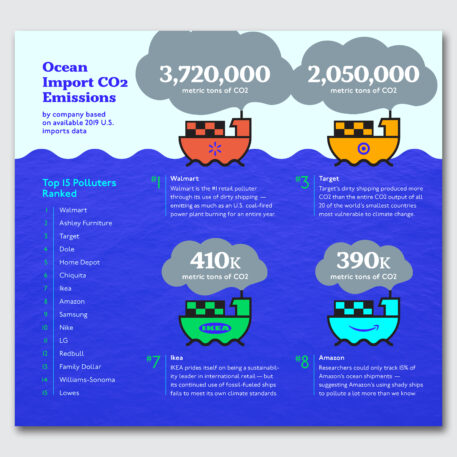
20 Jul These 15 companies have the biggest footprint from cargo shipping
Cargo ships carrying truckloads of clothing, cheap furniture, toys, and other goods destined for Walmart stores in the U.S. emitted an estimated 3.7 million tons of carbon dioxide in 2019—more than a coal-fired power plant running for a year, according to a new report. The report, from the nonprofits Pacific Environment and Stand.earth, calculates the carbon footprint and air pollution from fossil-fueled ships for the top importers of products sold in the U.S.
The world’s shipping fleet has quadrupled since the 1980s as manufacturing moved overseas. Outsourcing “is predicated on a reliance on fossil-fueled maritime shipping,” says Madeline Rose, climate campaign director at Pacific Environment. “It’s intrinsic to the business model of manufacturing overseas. And we felt like there has never been a legitimate public accounting of the public health and environmental externalities of that decision.”
Walmart tops the list in the report, followed by the furniture retailer Ashley, Target, Dole, Home Depot, Chiquita, Ikea, Amazon, Samsung, Nike, LG, Redbull, Family Dollar, Williams-Sonoma, and Lowes. Collectively, the report found, the companies were responsible for as much climate pollution from shipping imports to the U.S. as the energy used by 1.5 million homes. Cargo ships are also a major source of air pollution, including sulfur oxide, which is linked to asthma and an increased risk of cancer in the low-income communities living near ports. The report found that imports for the 15 companies on the list generated as much sulfur oxide as 2 billion cars and trucks, or more than 7 times more vehicles than are currently on the road in the U.S.

The emissions data used to compile the list isn’t easily accessible. The International Maritime Organization tracks emissions from shipping companies but doesn’t make it publicly available, and most brands don’t include cargo ship emissions in their voluntary climate reporting. (Ikea, one exception, has said that ocean transport is responsible for around 40% of the transportation emissions in its supply chain.) To create the report, the nonprofits combined data from cargo manifests with details about emissions from individual ships, and then linked each shipping route with customers like Target or Home Depot.
Manufacturing overseas would be a different prospect if the cost of the fuel used ships accounted for externalities like pollution. “I think what this report really underscores is that fossil fuel shipping is too too cheap,” says Rose. “Oil companies figured out that they could give the shipping industry the bottom of the barrel—this gross, nasty post refined version of oil, and that it would work in ship engines. And ever since then, the international shipping industry has been a lifeline industry for oil.”
Some companies could help shrink emissions by moving to more domestic manufacturing; Walmart, for example, said earlier this year that it expects to avoid 100 billion tons of emissions by investing in U.S. manufacturing. The nonprofits also argue that pollution fees should be charged when ships dock at ports, and that the Biden administration should create a “clean ship” standard that forces ships to reduce emissions over time.
They also say that companies should commit to zero-emissions shipping for their goods by 2030. Some technologies are readily available now. “Any one of these retailers could say to their carrier tomorrow, ‘I will not move my product with you on any cargo ship that does not include a wind-assist propulsion system,” Rose says. “Wind-assist” systems can cut emissions by 10-30%. Companies can also renegotiate their contracts with carriers to say that they want to be using zero-emissions ships as soon as they’re available. “We think that there are going to be commercially available zero-emission cargo ships on the water by 2023,” she says. “And it’s up to these retailers to help get their cargo on them.”
Source: Fast Company




Sorry, the comment form is closed at this time.